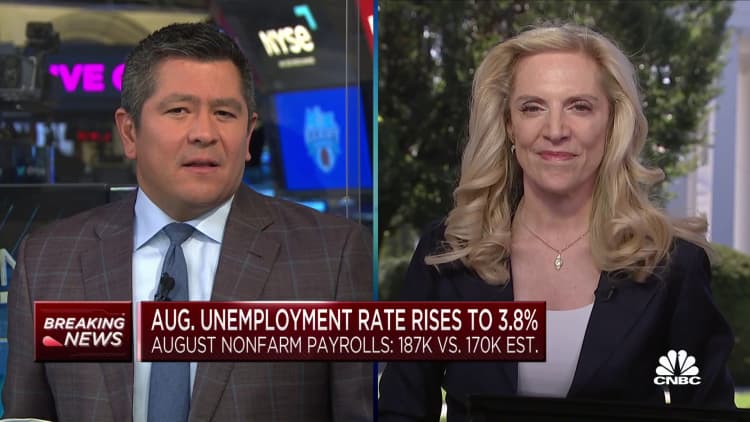Mario Tama | Getty Images
1. Slowing Job Growth
The Labor Department announced that the U.S. economy added 187,000 jobs in August.
Job growth is showing signs of decline, with an average of 150,000 jobs added in August compared to 201,000 in June.
However, this reading is consistent with the average of 190,000 jobs added per month from 2015 to 2019, according to Julia Pollak, chief economist at ZipRecruiter. Additionally, job gains in August were diversified across industries.
Last month’s job growth was also impacted by one-off factors such as ongoing strikes in Hollywood and trucking-sector layoffs resulting from the bankruptcy of Yellow Corp, said Aaron Terrazas, chief economist at Glassdoor.
Economists note that monthly job growth is still surpassing U.S. population growth, with estimates ranging from 70,000 to 150,000 jobs added per month.
2. Increase in Unemployment
The unemployment rate rose to 3.8% in August from 3.5% in July.
Economists observe that this increase is primarily due to more people entering the labor force and actively seeking employment, rather than job losses. In fact, employment rose in August.
While the unemployment rate has reached an 18-month high, it is not cause for major concern. The surge in the labor force contributed to this increase, according to Andrew Hunter, deputy chief U.S. economist at Capital Economics.
However, if new job seekers struggle to find employment and unemployment continues to rise, it could become worrisome, warns Julia Pollak.

3. The End of the Great Resignation
The trend of high resignation rates, known as the great resignation, appears to be ending.
Workers had been leaving their jobs at a significant rate in recent years due to attractive job opportunities and higher pay elsewhere. However, the rates of resignations and new hires have returned to pre-pandemic levels.
While some sectors are experiencing a decline in resignations compared to pre-pandemic levels, overall, this is a positive development.
It’s a numbers game. Apply early and often. Speed really, really, really matters.
Julia Pollak
Chief economist at ZipRecruiter
For example, the leisure and hospitality sector, as well as the accommodation and food services sector, have lower resignation rates compared to 2019.
4. Approaching Normal Job Openings
Job openings, which indicate employer demand for workers, remain high but have been decreasing.
In July, there were approximately 8.8 million job openings, the lowest since March 2021 but still higher than pre-pandemic levels. This is a significant decline from the peak of 12 million during the pandemic.

Job openings are approaching pre-pandemic levels, indicating a normalization of the labor market.
5. Slowing Wage Growth vs. Cost of Living
Wage growth has slowed down from record highs seen in previous months.
In August, the average three-month growth rate was 4.5%, down from 4.9% the previous month and a peak of 6.4% in January 2022.
Denial of responsibility! VigourTimes is an automatic aggregator of Global media. In each content, the hyperlink to the primary source is specified. All trademarks belong to their rightful owners, and all materials to their authors. For any complaint, please reach us at – [email protected]. We will take necessary action within 24 hours.


